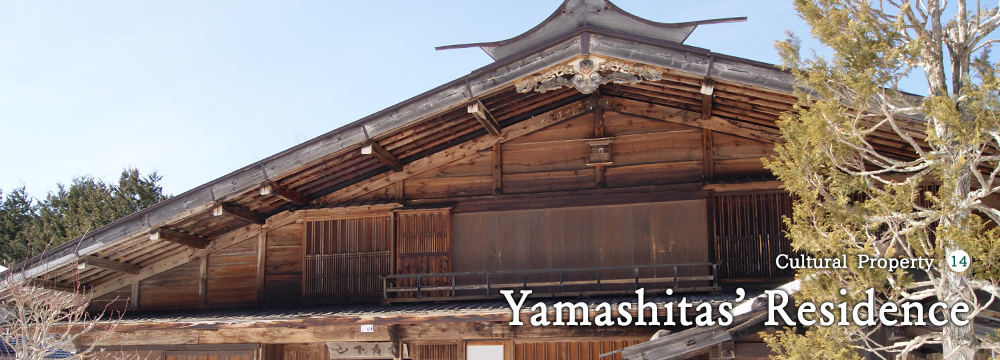
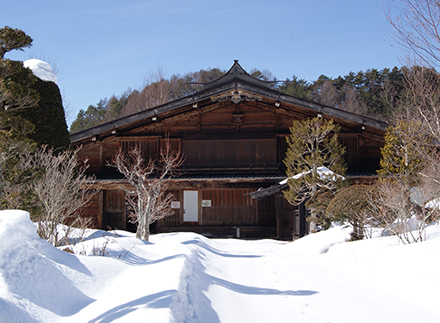
Story
The Yamashita family was known to own many Kisouma (Kiso horse) and lend them to farmers. For farmers, raising horses was another way of making a living.
Overview
The Yamashitas’ Residence is a Nagano Prefectural Treasure. The Yamashita family is known to have been one of four major horse owners in the Kiso Valley.
The old residence features the roof decorations hafu and gegyo of honmunezukuri (housing style unique to Nagano).
A sunken hearth, calligraphic works and paintings in the parlor, documents of horse doctors, and many other items that conjure up the past remain.
Points of Interest
Constructed in the late Edo period, the Yamashitas’ residence was designated as a Nagano Prefectural Treasure, and it has been preserved in close to its original state. The decorations on the roof are rare for a residence in a mountain village. A sunken hearth, calligraphic works and paintings in the room are displayed to learn about the past.
The Kaida Archaeological Museum stands next to the residence and displays some earthenware and stone tools from the Old Stone Age and the Jomon period (corresponds to the New Stone Age). The museum also shows what life in Kaida Highlands was like by means of models and miniatures.
Interview
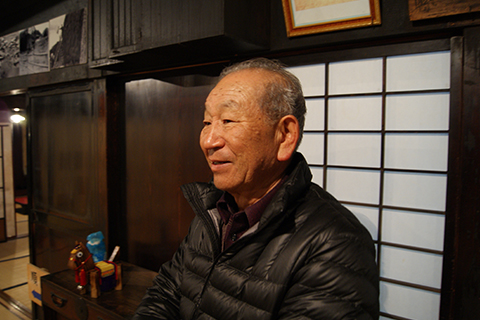
Kanamasa Kamura
A large residence stands out in the community of Kaida.
Entering the residence, we are surprised by the huge space inside.
Mr. Kanamasa Kamura, the curator of the property, guided us.
“Tell us about the Yamashita family.”
“This residence was built in the Edo period. An ancestor of the Yamashita family was a gifted horse doctor who worked for a horse magistrate of the Hida-Takayama Domain. The family owned up to 300 Kiso horses and ran a horse tenancy system.”
“They lent horses to farmers, and farmers used them for cultivation and bred them to sell at the horse market in Kisofukushima. That’s how people in Kaida used to make a living.”
“Of the total sale proceeds from the horses, one-fourth went to the farmer, and three-fourths went to the Yamashita family. Some 100 ponies were sold every year. That’s why the family could afford to build such a grand residence in the Edo period. The site area is 460 square meters.”
“As the Showa period began, the demand for horses went down, and they started to run a lodge out of their large residence. They ran the lodge for 30 years until 1991.
The family line of Yamashita failed when there was no successor in 1999.”
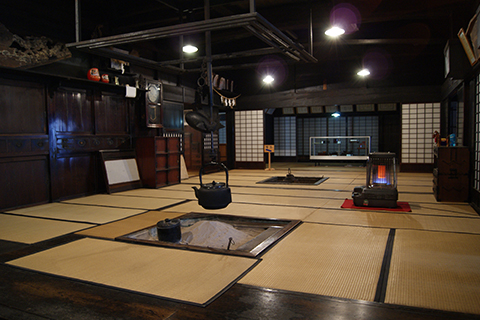
The wide interior - shiny black with the soot from the sunken hearth
“For a residence that is said to have been built in the Edo period, it’s in great shape.”
“It was built very sturdy. Stones are tightly fitted under the flooring to prevent humidity from rising from the ground. Nowadays we use concrete for the foundation, but the construction method is similar to the one used in the Edo period. In the ceiling, beams are set apart at 1.8 m intervals and crossbeams are no doubt interlaced with those. This makes the residence earthquake-resistant. It doesn’t sway from side to side. Even if an earthquake occurs with an intensity of Shindo (seismic intensity scale) 7, the residence will be OK. An ordinary house is not built in this way.”
“The interior is shiny black because of the soot from the sunken hearth. Because the timber has practically been smoked, it doesn’t decay and keeps out insects. Making the roof watertight will allow the residence to last for another 200 years.”
“However, none of the Five Trees of Kiso were used for this residence. Oak, hemlock fir, pine, chestnut and other trees were used instead. When it was being built, the feudal lord of Owari enacted the ban on the use of the Five Trees of Kiso. In part, it was to prevent destructive lumbering. Actually, Kiso-hinoki and sawara cypress fetched a high price for use in temples and shrines.
The timber used for Ise Grand Shrine is Kiso-hinoki cypress.
On the other hand, the storehouse built outside in 1891 is made entirely of hinoki. This kind of storehouse is very rare.”
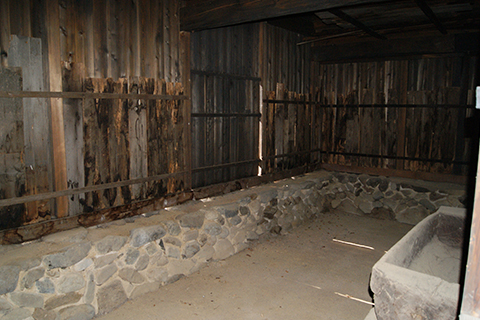
Horses were kept in the stable.
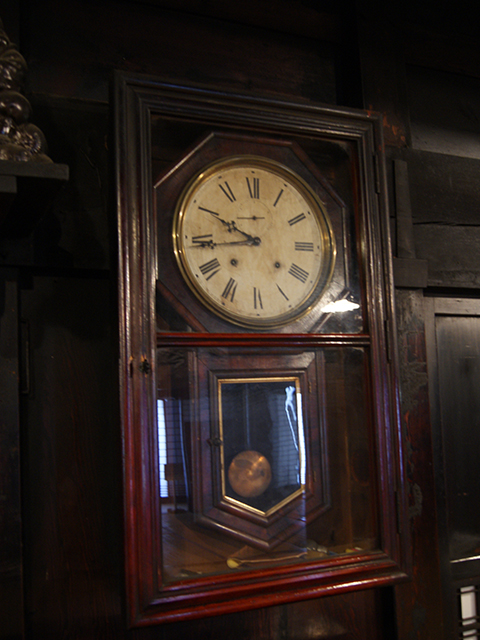
The wall clock made in the U.S.A.
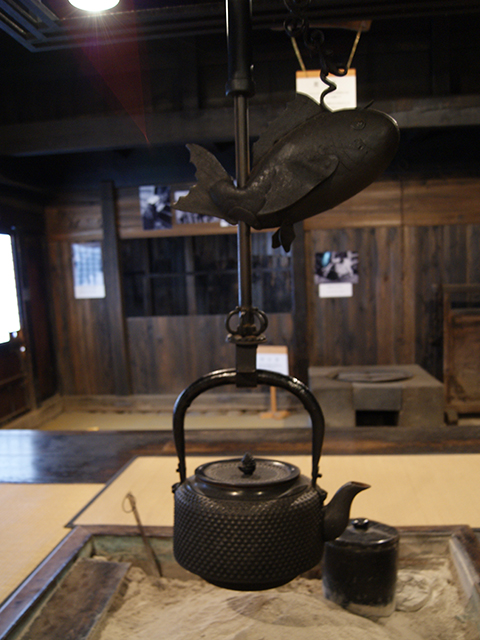
The pothook over the sunken hearth – high-tech in the Edo period
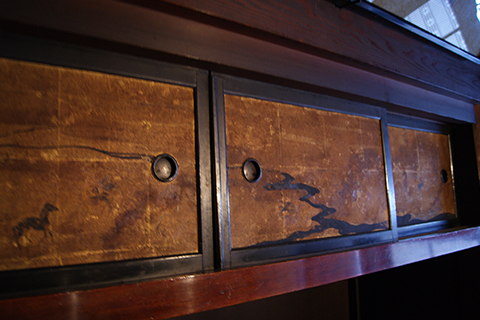
The gold-leaf cupboard
“Putting aside the size of the residence, the furniture inside is gorgeous.”
“The wall clock was made in the U.S.A. It works if you wind it up.
The Jizaikagi (pothook) hanging over the sunken hearth was made by a blacksmith in Hida. You can adjust the height as you like and rotate the iron kettle 360 degrees. It was high-tech in the Edo period.
Gold-leaf has been applied to the cupboard in the guest room, and the eating utensils on display are first-rate products of Wajima-nuri lacquerware.”
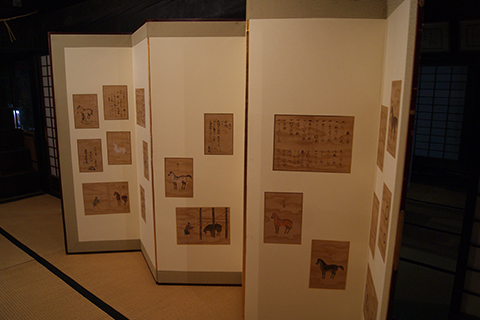
The folding screen is surprising large!
He showed us a stunning gold-leaf folding screen as high as 180 cm.
Japanese paper that has had gold-leaf applied to it will last at least 1,000 years. Painted on the Japanese paper is method of training horses. The gold folding screen is stunningly beautiful and doesn’t look like it is 400 years old.
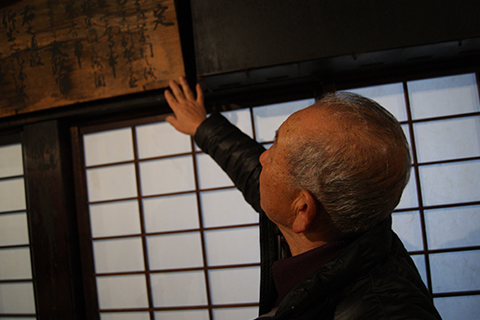
Mr. Kamura gave us detailed descriptions one by one.
They must have been quite rich to own this residence and furniture in the Edo period.
“The Yamashita family’s total proceeds from the sale of horses almost amounted to the village’s total budget. They surely had a lot of wealth. At the end of the Edo period, poverty-stricken governors and samurai had an eye on the family’s money, so a savings/credit association was founded. They visited the residence to borrow money. Some signed deeds remain to this day. Actually, there wasn’t much prospect of them paying back the money.” *laughs*
“Tell us more about the Yamashitas’ Residence.”
“It’s great that a building of the Edo period remains in such good condition. Nowadays it’d probably be impossible to build such a structure. Even a group of architects came to see the residence. More tourists from foreign countries have been visiting here as well.”
He gave us very valuable information about the history of the gorgeous residence of the Yamashita family and the high-level building techniques of the time.
Attractions
The Kaida Aechaeological Museum stands next to the residence and displays some earthenware and stone tools from the Old Stone Age and the Jomon period (corresponds to the New Stone Age). The museum also shows what life in Kaida Highlands was like by means of models and miniatures. Old Stone Age stone tools that were unearthed from the Yanagimata Ruins are definitely a must-see.
Access
From the closest station & interchange
From Kisofukushima Station on the JR Chuo Line
60 minutes by bus and walk
From the Ina Interchange on the Chuo Expressway
From the Ina Interchange on National road 361, 80 minutes by car
Address
Yamashitas’ Residence
2730-5 Kaidakogen, Kiso Town, Kiso-gun, Nagano Prefecture
Phone:0264-44-2007